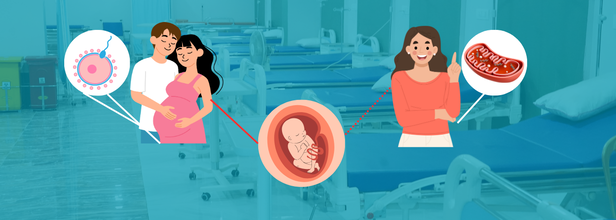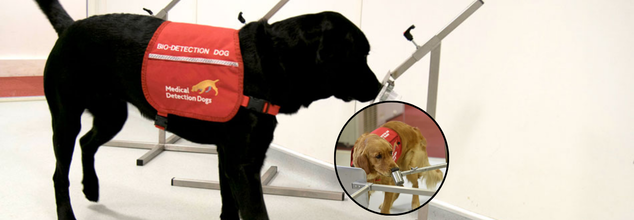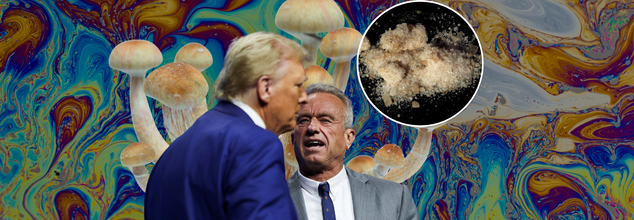- Health Conditions A-Z
- Health & Wellness
- Nutrition
- Fitness
- Health News
- Ayurveda
- Videos
- Medicine A-Z
- Parenting
- Web Stories
1 In 4 Indian Couples Are Overweight, Finds ICMR; How Obesity Is Now Becoming A Relationship Problem?

Credits: Canva
Obesity is no longer just a health issue, it is increasingly becoming a social phenomenon and a lifestyle disease. A recent study published in Current Developments in Nutrition, led by the Indian Council of Medical Research (ICMR) has found that 27.4% of Indian married couples share similar overweight or obese status.
Analyzing data from over 52,000 married couples across India using the National Family Health Survey (NFHS-5, 2019–21), the study points to a troubling pattern- in wealthier, urban households, especially among young couples, there is a significantly higher risk of both partners becoming overweight or obese. At its core, this research uncovers how daily habits, routines, and food choices within marriages are driving a quiet but dangerous health trend across the country.
Are Shared Habits A Risk Factor for Married Couples?
Unlike genetically linked conditions, obesity in married couples cannot be attributed to shared biology. So how does this mirroring occur? It is in environmental exposure, mutual behaviors, socio-economic context, and emotional co-regulation.
According to lead researcher Dr. Prashant Kumar Singh of ICMR’s National Institute of Cancer Prevention and Research, spousal similarities in health outcomes ranging from obesity and hypertension to smoking and sedentary behavior stem from shared lifestyles. These include eating patterns, physical activity (or lack thereof), screen time, media consumption, and stress management. Over time, habits converge especially in nuclear families with fewer social checks and less structured meal routines.
The study found that urban couples had a 38.4% concordance rate, significantly higher than rural couples (22.1%). Among the wealthiest households, this figure jumped to 47.6%, compared to only 10.2% in the poorest.
Where Obesity in Couples Is Rising Fastest In India?
Geographic disparities highlight how development and affluence correlate with rising obesity. States and territories with the highest spousal obesity concordance include:
- Kerala (51.3%)
- Jammu & Kashmir (48.5%)
- Manipur (47.9%)
- Delhi (47.1%)
- Goa (45.0%)
- Tamil Nadu (42.7%)
- Punjab (42.5%)
By contrast, states in eastern and northeastern India—where economic development is slower—showed much lower concordance rates, typically ranging from 19% to 22%.
“These figures underscore India’s uneven nutrition transition,” explains Dr. Shalini Singh, senior co-author of the study. “In wealthier regions, processed food consumption and reduced physical activity are becoming the norm. Marriage and cohabitation intensify these shared exposures, turning households into hotbeds of metabolic dysfunction.”
Is This A Disturbing Trend Among Under-30 Couples?
Perhaps the most concerning revelation is the early onset of weight gain in young couples. The study shows particularly high obesity concordance in couples under the age of 30, especially in Kerala (42.8%), Goa (37%), Jammu & Kashmir (31.6%), and Tamil Nadu (29.6%).
“This trend is alarming because early obesity increases the lifetime risk of chronic conditions like type 2 diabetes, cardiovascular disease, PCOS, and metabolic syndrome,” says Dr. Singh. “We’re seeing the impact of lifestyle-driven diseases unfold during what should be the most productive and healthiest years of life.”
The study also examined behavioral patterns that reinforce spousal weight concordance. For instance, 32.8% of couples reported regular television watching, while 39.6% reported newspaper reading, both indicative of sedentary behavior. Dependence on processed and ultra-processed food, especially in nuclear households, was another major contributor.
Interestingly, couples with similar education levels (about 45.2%) showed higher obesity concordance (31.4%), likely due to aligned food preferences, media consumption, and leisure routines.
The type of family structure also mattered. Nuclear families had a 28.9% concordance rate, higher than the 25.9% seen in joint families, where shared responsibilities and traditional food habits often foster more physical activity and balanced meals.
This Indian data fits into a much broader global trend. According to the World Obesity Atlas 2022, over 2.5 billion adults (43% of the global population) were overweight, and 890 million (16%) were obese. The burden of obesity now surpasses many infectious diseases and contributes to over 160 million years of healthy life lost annually due to comorbidities like heart disease, stroke, sleep apnea, and several cancers.
In India alone, obesity rates among adults are expected to climb significantly by 2040—27.4% of women and 30.5% of men, up from roughly 24% in 2021. If the patterns observed in married couples hold, these numbers could surge even faster than projected.
The study calls for a paradigm shift in how health interventions are designed. Rather than focusing on individuals, researchers urge a couple-based or household-level approach that takes into account the social dynamics of behavior change.
“Obesity is socially transmissible,” Dr. Singh emphasizes. “So the solution must also be social. Targeted public health messaging, fitness programs designed for couples, dietary counseling for families, and insurance incentives for preventive care at the household level are the need of the hour.”
Additionally, there’s a need to engage urban, affluent, and media-exposed demographics—who are often the earliest adopters of fast food, sedentary habits, and digital lifestyles—with interventions that feel relevant, aspirational, and sustainable.
As global health systems grapple with the rising burden of noncommunicable diseases, the Indian study offers a crucial insight: marriage can amplify risk—but also holds the key to prevention. By targeting couples early and acknowledging the influence of shared environments, public health systems can make strides in reversing obesity trends.
'Three-Parent-Baby' Technique: How UK Is Making Healthy Babies With DNA From Three People To Avoid Genetic Mitochondrial Disease

Credits: Canva
Mitochondrial Disease: In a groundbreaking development in reproductive medicine, researchers in the U.K. announced that eight healthy babies have been born using an experimental technique involving DNA from three people.
The method was developed to help prevent mothers from passing on devastating mitochondrial diseases to their children — conditions that can lead to seizures, muscle weakness, organ failure, developmental delays, and even death.
This scientific milestone was detailed in a study published in the New England Journal of Medicine on Wednesday.
Experts from Newcastle University in the U.K. and Monash University in Australia conducted the procedures, which used a technique known as mitochondrial donation treatment. The technique replaces faulty mitochondria, which are the tiny energy-producing structures in cells, with healthy ones from a donor.
What Is Mitochondrial DNA?
While most of our DNA is stored in the nucleus of our cells and inherited equally from both parents, a small but vital portion resides in the mitochondria and comes solely from the mother. Mutations in this mitochondrial DNA can lead to serious, and often fatal, genetic disorders in children.
During the in vitro fertilization (IVF) process, it is sometimes possible to detect these mutations early. However, in rare cases, such mutations go undetected — which is where mitochondrial donation becomes important.
In this method, scientists transfer the nuclear DNA from the mother's egg or embryo into a donor egg or embryo that contains healthy mitochondria but has had its own nuclear DNA removed. The resulting embryo contains nuclear DNA from the parents and mitochondrial DNA from a donor — essentially, the genetic input of three people.
A Scientific First Made Possible by Law
The U.K. became the first country in the world to legalize mitochondrial donation for clinical use in 2016, after years of ethical and scientific debates. Australia has also approved its use. However, the U.S. still prohibits any clinical research involving genetic modification of human embryos that could be inherited.
“This marks an important milestone,” said Dr. Zev Williams, director of the Columbia University Fertility Center in New York, who was not involved in the study. “Expanding the range of reproductive options will empower more couples to pursue safe and healthy pregnancies.”
As of now, 35 couples have been approved by the U.K.’s fertility regulator to undergo the procedure. Of the 22 patients treated in the reported study, eight babies have been born, and one more woman is still pregnant. Most of the children appear to be free of mitochondrial disease, though one child was found to have a slightly higher-than-expected level of abnormal mitochondria. Experts say this level is not currently cause for concern but will require monitoring.
A Tiny Donor Footprint
Despite the involvement of a third person, scientists emphasize that the genetic material from the donor is minimal. Dr. Robin Lovell-Badge, a stem cell expert at the Francis Crick Institute, noted that the donor’s mitochondrial DNA makes up less than 1% of the baby’s total genetic makeup — not enough to influence personal traits like appearance or personality.
“In fact, if you had a bone marrow transplant, you would carry much more of another person’s DNA,” he explained.
Hope for Families, But Questions Remain
The technology remains controversial in some circles. Critics warn that the long-term effects of such genetic manipulation are still unknown and could have unintended consequences for future generations. In the U.S., Congress has repeatedly blocked any government funding or approval of similar research.
Still, for many families, the promise of avoiding a life-threatening diagnosis is worth the risk.
Liz Curtis, whose daughter Lily died of mitochondrial disease in 2006 at just eight months old, now advocates for awareness and research. She founded the Lily Foundation in her daughter's memory and supports the work being done at Newcastle University.
Curtis said the diagnosis devastated her family. “Nobody could tell us what it was or how it would affect Lily. It was just a waiting game,” she recalled. “This new technique gives hope to families who’ve had very little of it.”
As science and ethics continue to evolve, the three-parent baby technique stands as a powerful, if complex, step forward in preventing inherited genetic illness.
Forget Blood Tests Now Dogs Can Sniff Out Parkinson’s Before Symptoms Appear

Credits: Medical Detection Dogs UK
Parkinson’s disease is notoriously difficult to diagnose early. Most patients aren’t identified until visible motor symptoms—tremors, stiffness, and slowness—are already affecting their lives. By that point, neurodegeneration has usually been ongoing for years. But a new study out of the UK could be a game-changer: specially trained dogs have proven they can detect Parkinson’s disease with remarkable accuracy—just by sniffing skin swabs.
In controlled clinical trials, two dogs achieved sensitivities between 70–80% and specificities exceeding 90% in detecting Parkinson’s disease from the scent of sebum, an oily substance secreted by the skin. That’s not just impressive—it rivals many of today’s most advanced diagnostic tools.
Does Parkinson’s Has a Scent?
What exactly are dogs smelling? Turns out, Parkinson’s isn’t just a neurological disease. It also affects how the body metabolizes and produces oils on the skin. These changes lead to a unique profile of volatile organic compounds (VOCs)—essentially odor molecules—that trained dogs can detect.
The research builds on previous anecdotal reports, including that of Joy Milne, a Scottish woman who famously detected a musky scent from her husband years before he was diagnosed with Parkinson’s. Scientists later confirmed that this scent wasn’t imaginary—it was chemically real. Dogs, with their 10,000x more sensitive noses, just happen to be better equipped than humans at picking it up.
How The Dogs Were Trained?
Researchers at the Universities of Bristol and Manchester collaborated with Medical Detection Dogs, a UK-based charity, to test whether Parkinson’s has a detectable odor signature. They began with 10 dogs and narrowed it down to two standouts: a male Golden Retriever and a Labrador-Golden mix.
Over the course of 38 to 53 weeks, these dogs were trained using 205 cotton swab samples collected from patients' backs—some with Parkinson’s, others without. Dogs were rewarded when they correctly identified samples from individuals with the disease. Importantly, the study was double-blind: neither the trainers nor the researchers knew which swabs were which during testing, ensuring unbiased results.
When the final test arrived—100 brand-new samples the dogs had never sniffed before—the animals performed exceptionally well. One dog hit 70% sensitivity and 90% specificity, while the other clocked in at 80% sensitivity and an astounding 98% specificity.
For context, that level of performance is on par with several existing diagnostic tests and better than previous scent-based trials involving cancers or infections.
Currently, there’s no blood test or brain scan that definitively diagnoses Parkinson’s early. Clinicians rely on watching for physical symptoms, which means by the time you’re diagnosed, significant damage may have already occurred.
Detection dogs could change that. By identifying Parkinson’s via skin swabs—before symptoms show up—these animals could help start the treatment process earlier, potentially slowing disease progression or improving long-term outcomes.
It’s especially meaningful in rural or underserved areas, where neurologists and movement disorder specialists are harder to access. A non-invasive, rapid screening tool—even if it’s a dog—could fill critical gaps.
Parkinson’s patients often develop seborrheic dermatitis, a condition that increases the production of sebum. In those with Parkinson’s, this sebum is chemically different. Dogs can detect those changes.
This builds on previous studies which have shown that diseases like cancer, malaria, and even COVID-19 can subtly change the body’s scent signature. The nose—particularly a canine one—may be among the most overlooked diagnostic tools in medicine.
And while dogs won’t be showing up in every clinic just yet, the data they provide is already helping researchers design electronic noses—devices that mimic canine olfaction and can detect VOCs in human sweat, sebum, or breath.
Are There Any Limitations Of This Kind Of Detection?
Of course, the idea of using dogs as diagnostic tools has its limits. Training a single dog takes nearly a year and is resource-intensive. Only a small number of dogs are temperamentally suited to this kind of highly focused scent work. And the study still doesn’t explain why some Parkinson’s patients’ samples were easier for dogs to detect than others.
Researchers also emphasize that dogs would not replace neurologists—but they could be used as a pre-screening tool, flagging individuals who should undergo further clinical evaluation.
The dogs in this study worked only with drug-naive patients—those who hadn’t yet started medications—meaning the scent signature they detected wasn’t masked or altered by pharmaceutical treatment. Future research may explore whether medication changes a patient’s odor profile or affects detection accuracy.
How Will This Change the Future of Parkinson’s Diagnosis?
Quite possibly, if scientists can isolate the exact VOCs that signal Parkinson’s—and replicate what dogs detect with sensors or lab tests—we could one day have a rapid, affordable, and non-invasive way to diagnose the disease long before traditional symptoms show up.
That would mark a sea change in Parkinson’s treatment strategy: from managing symptoms to preemptively addressing the disease at its earliest, most treatable stage.
Until then, we may just need to trust our four-legged friends to lead the way—nose first.
Dogs are proving to be more than just loyal companions—they’re potentially medical detectives. With their powerful noses, they may soon help detect Parkinson’s earlier than ever before, offering hope for millions living with or at risk of the disease.
RFK Jr. And Trump Cabinet Want Psychedelics To Be Legal After FDA Shut Down; What This Means For The Controversial Drug?

In a move that would have seemed unthinkable just a decade ago, a new presidential administration is placing psychedelics front and center in its health policy agenda. Health Secretary Robert F. Kennedy Jr. told Congress that psychedelic-assisted therapy—long stigmatized and sidelined—is on track for federal approval “within 12 months.”
That timeline stunned even long-time advocates. But it aligns with a wider political shift, not just in progressive strongholds but also in conservative territories like Texas. Former Trump officials including ex-Governor Rick Perry and Secretary of Veterans Affairs Doug Collins have expressed support for expanding access to psychedelics for treating PTSD, depression, and addiction.
The timing is no accident. The U.S. Food and Drug Administration (FDA) recently dealt a heavy blow to advocates by rejecting MDMA-assisted therapy for PTSD, citing concerns over research integrity. The decision was a major setback for the psychedelic movement—but it may also have sparked a political counter-response.
MDMA, also known as ecstasy, had long been the frontrunner in the race to integrate psychedelics into clinical medicine. The Multidisciplinary Association for Psychedelic Studies (MAPS), which backed MDMA research for decades, had hoped for a groundbreaking FDA approval this year.
Instead, FDA advisors voted overwhelmingly against it, criticizing data collection methods, researcher bias, and missing adverse event reports. One panelist described the trial environment as bordering on “cult-like.” Critics argued that while results appeared promising, the data lacked scientific rigor.
The agency hasn’t entirely shut the door on MDMA, but it's clear that any future approval will come with strict conditions—or require new clinical trials entirely.
Rather than retreating, psychedelic advocates now seem to be finding powerful allies. Kennedy’s endorsement of psychedelic therapies stems in part from personal experience—he’s spoken openly about family members and friends who found healing through these substances.
Meanwhile, Rick Perry and other Republican figures are pushing forward with state-level projects that bypass the slow-moving federal process. Texas recently approved $50 million to fund research into ibogaine, a powerful and controversial psychedelic derived from a West African plant.
Ibogaine remains a Schedule I substance, in the same legal category as heroin. But veterans and policymakers in Texas are betting on it to address the state’s opioid crisis and support those suffering from war-related trauma.
“It’s not just red states or blue states anymore—it’s veterans, families, people from across the spectrum who are saying: what we’re doing isn’t working,” said Bryan Hubbard, co-founder of Americans for Ibogaine.
What is The Ibogaine Experiment?
Ibogaine is not your typical psychedelic. While small studies suggest it may reset the brain’s reward system and break addictive cycles, it’s also known for severe side effects—including potentially lethal heart arrhythmias.
Veterans like Marcus Capone say it changed their lives. Capone, a former Navy SEAL, describes his first ibogaine experience as “a complete purge.” After years of therapy and medication, one session left him with “no more anxiety, no more depression.”
His nonprofit, VETS, has already sent over 1,000 veterans abroad for psychedelic treatment. But federal officials remain cautious. Former NIDA director Nora Volkow acknowledged ibogaine’s promise but warned it “would be dead in the water” for FDA approval in its current form due to toxicity risks.
Still, the National Institutes of Health is now supporting development of synthetic ibogaine analogs—evidence that even federal agencies are evolving.
Fast-Tracking Psychedelic Drug Approval—At What Cost?
FDA commissioner Marty Makary, who reports to RFK Jr., recently announced efforts to accelerate drug approvals that serve “American health interests.” One proposed framework could shrink the FDA’s review process from six months to just one.
Makary has also floated the idea of relaxing placebo-controlled trial requirements—controversial in psychedelic research because participants often know if they received the real drug. That change could open the door for faster results, but it also raises concerns about scientific integrity.
Critics like Yale psychiatrist Philip Corlett are sounding the alarm. “The public is ahead of the science right now,” he warns. “If RFK and others are serious, they should stick to the benchmarks of clinical research. Otherwise, this could backfire.”
What Happens to MDMA Now?
The future of MDMA therapy is uncertain. FDA regulators could override the advisory panel’s vote and approve the drug with new safeguards, such as risk evaluation and mitigation strategies (REMS). Another possibility: conditional approval with a requirement for post-market research.
But there’s also a chance the drug could be shelved, at least temporarily, while Lykos—the company behind the MDMA trials—regroups and launches a new study. That could delay approval by years.
“The hope was that if we did the science right, the data would speak for itself,” said trial investigator Ingmar Gorman. “But that’s not how it played out.”
The psychedelic renaissance now finds itself in a paradox: increasingly mainstream and bipartisan in political circles, but still fragile in the eyes of regulatory science.
States like Texas and Oregon are forging ahead. Veterans and nonprofits are doing the groundwork. And the federal government, under a high-profile and controversial health secretary, appears willing to fast-track approval processes but speed and politics won’t substitute for rigorous evidence. If the next wave of psychedelic approvals is rushed or mishandled, it could risk discrediting therapies that millions of patients might one day benefit from.
© 2024 Bennett, Coleman & Company Limited

